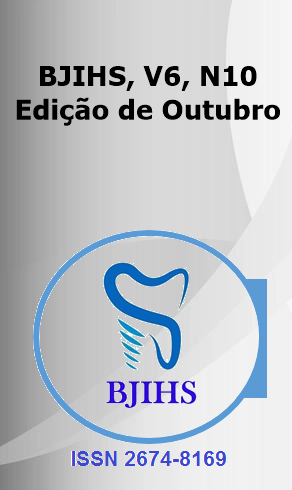Resumo
A análise preditiva de complicações pós-operatórias em cirurgia geral emergiu como uma ferramenta de grande relevância para melhorar a segurança do paciente e otimizar o uso de recursos hospitalares. Por meio da integração de técnicas avançadas de aprendizado de máquina e modelos estatísticos, é possível prever, com maior precisão, quais pacientes estão em risco de desenvolver complicações graves, como infecções, tromboembolismo venoso e falência de órgãos. Este artigo oferece uma revisão crítica da literatura sobre os principais métodos de análise preditiva, incluindo regressão logística, florestas aleatórias, máquinas de vetor de suporte (SVM) e redes neurais, bem como das variáveis preditivas mais relevantes, como idade, comorbidades pré-existentes, estado nutricional e características intraoperatórias. Também discutimos as aplicações clínicas desses modelos, que incluem a personalização dos cuidados, a melhoria da alocação de recursos e a redução de custos hospitalares. Embora os modelos preditivos apresentem benefícios significativos, a implementação clínica enfrenta desafios importantes, como a qualidade dos dados, a generalização dos modelos para diferentes contextos e a interpretabilidade das previsões. Concluímos que, apesar desses desafios, a análise preditiva representa uma fronteira promissora na medicina perioperatória, com potencial para melhorar substancialmente os desfechos cirúrgicos, desde que acompanhada de esforços tecnológicos e éticos adequados.
Referências
ABI-RAFEH, Jad et al. Large language models and artificial intelligence: a primer for plastic surgeons on the demonstrated and potential applications, promises, and limitations of ChatGPT. Aesthetic Surgery Journal, v. 44, n. 3, p. 329-343, 2024.
ÁINLE, Fionnuala Ní; KEVANE, Barry. Which patients are at high risk of recurrent venous thromboembolism (deep vein thrombosis and pulmonary embolism)?. Blood advances, v. 4, n. 21, p. 5595-5606, 2020.
ARINA, Pietro et al. Prediction of complications and prognostication in perioperative medicine: a systematic review and PROBAST assessment of machine learning tools. Anesthesiology, v. 140, n. 1, p. 85-101, 2024.
AWUAH, Wireko Andrew et al. Recent outcomes and challenges of artificial intelligence, machine learning and deep learning applications in neurosurgery–Review applications of artificial intelligence in neurosurgery. World Neurosurgery: X, p. 100301, 2024.
BALCH, Jeremy A. et al. Risk-specific training cohorts to address class imbalance in surgical risk prediction. JAMA surgery, 2024.
BONDE, Alexander et al. Assessing the utility of deep neural networks in predicting postoperative surgical complications: a retrospective study. The Lancet Digital Health, v. 3, n. 8, p. e471-e485, 2021.
DHARAP, Satish B.; BARBANIYA, Priya; NAVGALE, Shantanu. Incidence and risk factors of postoperative complications in general surgery patients. Cureus, v. 14, n. 11, 2022.
FADHIL, R. H.; ABUD, H. M.; ALWAN, L. J. Post-abdominal surgery respiratory complications at surgical wards of Baghdad teaching hospital. JMSP, v. 10, n. 2, p. 51-65, 2024.
GILLESPIE, Brigid M. et al. Worldwide incidence of surgical site infections in general surgical patients: a systematic review and meta-analysis of 488,594 patients. International Journal of Surgery, v. 95, p. 106136, 2021.
GUMMADI, Sriharsha; PASCUAL L, Jose L. Postoperative Neurologic Complications in the Older Adult: Surgical Care for Current Geriatric Reports (https://www. springer. com/journal/13670). Current Geriatrics Reports, v. 13, n. 2, p. 61-69, 2024.
JIN, George JC. Postoperative Complications. In: Cataract Surgery from Routine to Complex. CRC Press, 2024. p. 181-205.
KASHLAN, Besher; KINNO, Menhel; SYED, Mushabbar. Perioperative myocardial injury and infarction after noncardiac surgery: a review of pathophysiology, diagnosis, and management. Frontiers in Cardiovascular Medicine, v. 11, p. 1323425, 2024.
KURANI, Akshit et al. A comprehensive comparative study of artificial neural network (ANN) and support vector machines (SVM) on stock forecasting. Annals of Data Science, v. 10, n. 1, p. 183-208, 2023.
LI, Sibei et al. Integrating StEP-COMPAC Definition and Enhanced Recovery after Surgery Status in a Machine-learning-based Model for Postoperative Pulmonary Complications in Laparoscopic Hepatectomy. Anaesthesia Critical Care & Pain Medicine, p. 101424, 2024.
MERATH, Katiuscha et al. Use of machine learning for prediction of patient risk of postoperative complications after liver, pancreatic, and colorectal surgery. Journal of Gastrointestinal Surgery, v. 24, n. 8, p. 1843-1851, 2020.
NWAIMO, Chioma Susan; ADEGBOLA, Ayodeji Enoch; ADEGBOLA, Mayokun Daniel. Transforming healthcare with data analytics: Predictive models for patient outcomes. GSC Biological and Pharmaceutical Sciences, v. 27, n. 3, p. 025-035, 2024.
ODAT, Ramez M. et al. Pre-and post-surgery: advancements in artificial intelligence and machine learning models for enhancing patient management in infective endocarditis. International Journal of Surgery, p. 10.1097, 2024.
SIOUTAS, Georgios; TSOULFAS, Georgios. Frailty assessment and postoperative outcomes among patients undergoing general surgery. The Surgeon, v. 18, n. 6, p. e55-e66, 2020.
WELLS, Cameron I. et al. Variation in the definition of ‘failure to rescue’from postoperative complications: a systematic review and recommendations for outcome reporting. Surgery, 2024.
YANG, Xue et al. Biomedical big data technologies, applications, and challenges for precision medicine: A review. Global Challenges, v. 8, n. 1, p. 2300163, 2024.
YIN, Yaolin et al. Survival analysis of laparoscopic surgery and open surgery for hilar cholangiocarcinoma: a retrospective cohort study. World Journal of Surgical Oncology, v. 22, n. 1, p. 58, 2024.
YOUNIS, Hussain A. et al. A systematic review and meta-analysis of artificial intelligence tools in medicine and healthcare: applications, considerations, limitations, motivation and challenges. Diagnostics, v. 14, n. 1, p. 109, 2024.

Este trabalho está licenciado sob uma licença Creative Commons Attribution 4.0 International License.
Copyright (c) 2024 Ana Carolina de Mello Leoni, Bruna Furukawa, Júlio Cezar Cardoso de Oliveira, Pedro Henrique Rodrigues Ferreira, Fernanda Machado Maran, Gustavo Alves Colombo, Matheus Henrique Vilani, Robner Carlos Lopes Assunção, Bruna Luisa Facciulo, Bernardo Coradi Burille, Amanda Brosda Packer, Tatiane de Souza Domingos, Leonardo Gauginski Marchetti
